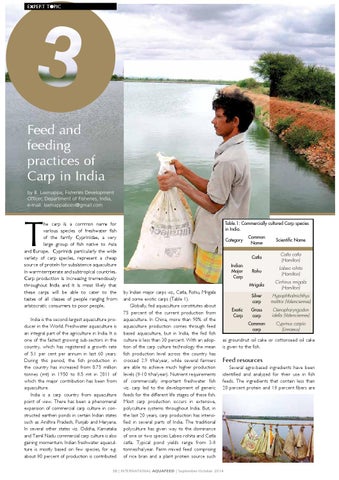3 EXPERT T●PIC
Feed and feeding practices of Carp in India by B. Laxmappa, Fisheries Development Officer, Department of Fisheries, India, e-mail: laxmappaboini@gmail.com
T
he carp is a common name for various species of freshwater fish of the family Cyprinidae, a very large group of fish native to Asia and Europe. Cyprinids particularly the wide variety of carp species, represent a cheap source of protein for subsistence aquaculture in warm temperate and subtropical countries. Carp production is increasing tremendously throughout India and it is most likely that these carps will be able to cater to the tastes of all classes of people ranging from aristocratic consumers to poor people. India is the second-largest aquaculture producer in the World. Freshwater aquaculture is an integral part of the agriculture in India. It is one of the fastest growing sub-sectors in the country, which has registered a growth rate of 5.1 per cent per annum in last 60 years. During this period, the fish production in the country has increased from 0.75 million tonnes (mt) in 1950 to 8.5 mt in 2011 of which the major contribution has been from aquaculture. India is a carp country from aquaculture point of view. There has been a phenomenal expansion of commercial carp culture in constructed earthen ponds in certain Indian states such as Andhra Pradesh, Punjab and Haryana. In several other states viz. Odisha, Karnataka and Tamil Nadu commercial carp culture is also gaining momentum. Indian freshwater aquaculture is mostly based on few species, for e.g. about 80 percent of production is contributed
Table.1: Commercially cultured Carp species in India. Category
Indian Major Carp
by Indian major carps viz., Catla, Rohu, Mrigala and some exotic carps (Table 1). Globally, fed aquaculture constitutes about 75 percent of the current production from aquaculture. In China, more than 90% of the aquaculture production comes through feed based aquaculture, but in India, the fed fish culture is less than 30 percent. With an adoption of the carp culture technology the mean fish production level across the country has crossed 2.9 t/ha/year, while several farmers are able to achieve much higher production levels (8-10 t/ha/year). Nutrient requirements of commercially important freshwater fish viz. carp led to the development of generic feeds for the different life stages of these fish. Most carp production occurs in extensive, polyculture systems throughout India. But, in the last 20 years, carp production has intensified in several parts of India. The traditional polyculture has given way to the dominance of one or two species Labeo rohita and Catla catla. Typical pond yields range from 3-8 tonnes/ha/year. Farm mixed feed comprising of rice bran and a plant protein source such
Exotic Carp
Common Name
Scientific Name
Catla
Catla catla (Hamilton)
Rohu
Labeo rohita (Hamilton)
Mrigala
Cirrhinus mrigala (Hamilton)
Silver carp
Hypophthalmichthys malitrix (Valenciennes)
Grass carp
Ctenopharyngodon idella (Valenciennes)
Common carp
Cyprinus carpio (Linnaeus)
as groundnut oil cake or cottonseed oil cake is given to the fish.
Feed resources
Several agro-based ingredients have been identified and analyzed for their use in fish feeds. The ingredients that contain less than 20 percent protein and 18 percent fibers are
38 | INTERNATIONAL AQUAFEED | September-October 2014
